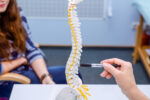Bone mineral density testing rates in Cushing’s remain low, despite risk
Only about 6% underwent BMD analysis within two years of their diagnosis
Written by |

Despite the known risk of osteoporosis among people with Cushing’s syndrome, only about 6% underwent bone mineral density (BMD) analysis within two years of diagnosis, a study using an insurance database shows.
BMD testing assesses levels of calcium and other minerals in bone. Osteoporosis, which is characterized by weak, brittle bones, was diagnosed in 12.6% of patients screened, with a higher prevalence in older patients and tobacco smokers.
“These findings highlight the need for improved adherence to screening guidelines, particularly for high-risk populations, to better manage and prevent osteoporosis in Cushing’s syndrome patients,” the researchers wrote. The study, “Notable lacking of bone mineral density measurement in cushing syndrome: a nationwide study based on the US insurance claim database,” was published in Osteoporosis International.
Cushing’s syndrome refers to any condition where the hormone cortisol is levated. It may result as a side effect of certain medications or to internal problems, mainly tumors in the pituitary gland, where it’s referred to as Cushing’s disease.
Excessive cortisol may disrupt bone metabolism and people with the condition frequently show loss of bone mass and osteoporosis. However, “the prevalence of BMD measurement among individuals with [Cushing’s] and the factors contributing to the oversight of low BMD in [these] patients are not fully understood,” the researchers wrote.
Analyzing BMD rates in Cushing’s
Here, researchers in Iran and the U.S. retrospectively studied data from a U.S. insurance claims database from 2010 to 2020 to learn more about the use of bone mineral density testing in people with Cushing’s syndrome. The study identified 53,101 people with Cushing’s, ages 55 and older, of whom 6.4% (3,399) had a bone mineral density evaluation within two years of their diagnosis.
BMD was more commonly assessed in women than in men (7.9% vs. 2.6%) and younger patients (62.8 vs. 65.2 years in non-evaluated patients). Among age groups, BMD testing was more common in patients ages 55 to 59 years (8.31%) and less frequent in those ages 75 to 79 (2.1%).
Patients in the Midwest had the highest rate of testing (7.1%) and those with commercial insurance (7.5%) had a higher testing rate than patients with other insurance types.
Groups associated with reduced BMD testing included men (69% less likely to undergo testing), patients with more severe coexistent conditions, or comorbidities (11% less likely) and older patients (4% less likely). Patients with obesity were 51% more likely screened. Those with chronic kidney disease, diabetes, and who were tobacco smokers were also more likely to be tested.
Among patients who had BMD testing, 12.6% were diagnosed with osteoporosis. These patients were significantly older than those without the condition (64.1 vs. 62.6 years), with the highest prevalence of osteoporosis observed among ages 70 to 74 (21.2%). Smokers and patients with ischemic heart disease, which is caused by narrowing heart arteries, chronic pulmonary or kidney disease, and cerebrovascular conditions, also had a higher prevalence of osteoporosis.
A multivariate analysis, which analyzes several variables to identify potential associations, confirmed that smoking increased the probability of osteoporosis by 41%, while older age did so by 4%.
“The main findings of our study revealed that, despite guideline recommendations, BMD screening in patients with Cushing’s syndrome is not being conducted as frequently as expected,” the researchers wrote. “This is alarming because most cases of osteoporosis remain undiagnosed until a fracture occurs.”
The researchers said this is a particular concern for high-risk groups, such as older patients, those who have more severe coexistent conditions, and smokers.






